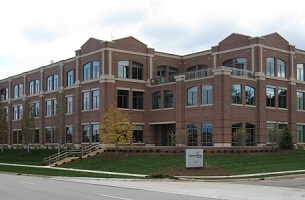
Innovation Park, Notre Dame’s start-up incubator for transforming innovations into viable marketplace ventures, has earned LEED silver certification from the U.S. Green Building Council. The 55,000 square foot building, opened in October 2009 and designed to encourage creativity and collaboration, was also built to rigorous standards that promote energy and water efficiency and reduce waste.
“Innovation Park is intended to foster cutting-edge ideas and technologies,” said Heather Christophersen, Director of Sustainability. “LEED design and construction fits right in with this culture of innovation by encouraging continuous improvement in green building.”
A well-insulated building envelope in combination with highly efficient mechanical and electrical systems were designed and installed to create a building which will achieve an energy savings of 17% over comparable buildings. A white roof was installed to reflect heat in the summer, reducing the amount of energy necessary to cool the building. Occupancy sensors turn lights and additional ventilation off when users are not in a room. Condensation from air conditioning units is captured and reused within the mechanical systems, while energy is recovered from exhausted air and reused to heat or cool the building.
Water saving fixtures sinks, toilets, urinals and shower heads were installed to reduce water consumption by 49% while efficient irrigation systems reduce potable water consumption for irrigation by 52%. Furthermore, 100% of the storm water from the site is directed to a centralized settlement basin where water is allowed to percolate back into the ground.
10 Bicycle racks were provided to encourage occupants to ride bicycles to the building and a shower and changing facility was installed to give bicycle riders a place to change and shower after biking to the building. Preferred parking spaces for low-emitting and fuel efficient vehicles are also provided to encourage the use of these vehicles.
Approximately 80% of construction waste was diverted from landfill and great thought was given to the building materials used as well: At least 10% of the building materials used in the project were processed and harvested within 500 miles of the building site in order to reduce transportation impacts and 100% of wood used in the building is FSC certified, ensuring that it originated from responsibly managed forests.